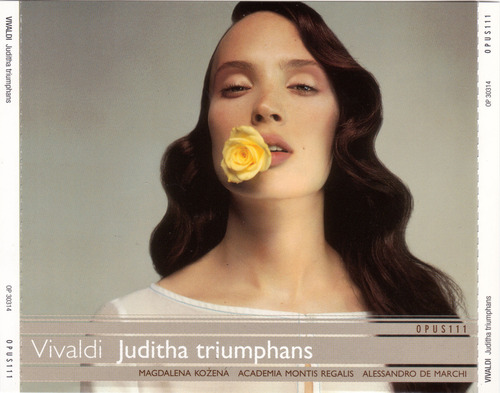Vivaldi Juditha Triumphans
A fullblooded experience‚ thrillingly sung
View record and artist detailsRecord and Artist Details
Composer or Director: Antonio Vivaldi
Genre:
Vocal
Label: Opus 111
Magazine Review Date: 13/2001
Media Format: CD or Download
Media Runtime: 0
Mastering:
DDD
Catalogue Number: OP30314

Tracks:
| Composition | Artist Credit |
|---|---|
| Juditha Triumphans |
Antonio Vivaldi, Composer
Academia Montis Regalis Alessandro de Marchi, Conductor Anke Herrmann, Soprano Antonio Vivaldi, Composer Coro di Camera Accademia Nazionale di Santa Cecilia Magdalena Kozená, Soprano Maria José Trullu, Mezzo soprano Marina Comparato, Mezzo soprano Tiziana Carraro, Mezzo soprano |
Author: kYlzrO1BaC7A
Vivaldi’s only surviving oratorio‚ Juditha triumphans (1716)‚ with its strongly characterised roles and luxuriant orchestration‚ is a true Baroque masterpiece. Like Handel’s Roman oratorio‚ La Resurrezione (1708)‚ Vivaldi’s Venetian Juditha was designed to impress its audiences. The Ospedale della Pietà‚ where Vivaldi was maestro dei concerti‚ competed with three other similar institutions for the patronage of wealthy Venetians‚ and the annual Lenten performances offered the perfect opportunity.
Alessandro de Marchi has departed from other recent interpreters by daring to transpose the tenor and bass choral parts up an octave‚ as is widely believed was done by Vivaldi himself to accommodate the choir of the Pietà. The effect is breathtaking: the compressed‚ female choral textures positively gleam‚ especially in the music depicting the Assyrian cause (for example‚ the rousing chorus that opens Part 1) or the aspirations of the Jews (the hushed prayer that ends Part 1 and the celebration that concludes the oratorio). From his superb cast of female soloists‚ de Marchi coaxes remarkable and dramatically convincing male vocal timbres. Maria José Trullu projects the various sides of Holofernes‚ who is depicted not merely as a monster but as capable of dignity and charm (‘Nil arma‚ nil bella’ and ‘Sede‚ o cara’)‚ even if ultimately incautious; she infuses her tone with a warmth and richness that countertenors might envy. Marina Comparato‚ as Holofernes’ loyal aidedecamp‚ Vagaus‚ sings lithely in Part 1 and gently in Part 2 before his shocked discovery of Holofernes’ headless body – in a gripping passage of recitative – impels him to seek vengeance. Tiziana Carraro as Ozias appears only in Part 2‚ confidently predicting the end of the ‘godless enemy’ and intoning timely prayers.
Magdalena Ko½ená‚ the Bethulian widow Judith‚ casts a spell on those who only hear her: as well as Holofernes. She sings with poise almost throughout‚ as she enters the enemy camp (‘Quocum Patriae me ducit amore’)‚ meets and seduces Holofernes‚ reflects on the transitoriness of life and prays for peace and strength before murdering the sleeping Holofernes (‘In somno profundo’). Only then‚ as she carries out her heroic – if horrific – mission does she fully convey her emotion (track 14 of the third disc). As her handmaiden Abra‚ Anke Herrmann‚ lighter in voice‚ sings neatly of her selfless loyalty and encouragement to Judith. Listeners will note that in lieu of ensembles‚ Vivaldi cast many of his recitatives as carefully crafted dialogues.
The instrumentation offers a veritable treasure trove of unusual and evocative instruments‚ even for the time: a pair of clarinets to characterise the dissolute Assryian soldiers‚ recorders for ‘nocturnal breezes’ and a quartet of theorbos to depict the preparation of the feast. For Judith there is a chalumeau imitating a turtledove‚ a viola d’amore‚ a mandoline and a contemplative consort of ‘viole all’inglese’ to accompany her prayers; for Holofernes there is a solo oboe. These and the more common obbligato and continuo instruments of the day are affectingly played by the musicians of the Academia Montis Regalis. To address the loss of the opening sinfonia‚ de Marchi‚ like the conductors before him‚ turned to Vivaldi’s concertos and chose RV562‚ composed at much the same time as Juditha and in the preferred key of D major‚ with a suitably military Allegro followed by a suspenseful Grave. At every turn there is ample evidence of the care de Marchi has lavished on this performance: the returns of the first sections of arias (the da capos) are ornamented and‚ rather exceptionally‚ introduced by stylishly improvised transitions‚ most often by one of the harpsichordists (you will also hear a wonderful example connecting the movements of the Sinfonia). By comparison with de Marchi’s strongly projected‚ dramatically engaging reading‚ Robert King’s seems less fullblooded and relatively static.
Congratulations all round for an outstanding recording. Let’s hope that another Vivaldi oratorio turns up soon!
Discover the world's largest classical music catalogue with Presto Music.

Gramophone Digital Club
- Digital Edition
- Digital Archive
- Reviews Database
- Full website access
From £8.75 / month
Subscribe
Gramophone Full Club
- Print Edition
- Digital Edition
- Digital Archive
- Reviews Database
- Full website access
From £11.00 / month
Subscribe
If you are a library, university or other organisation that would be interested in an institutional subscription to Gramophone please click here for further information.




